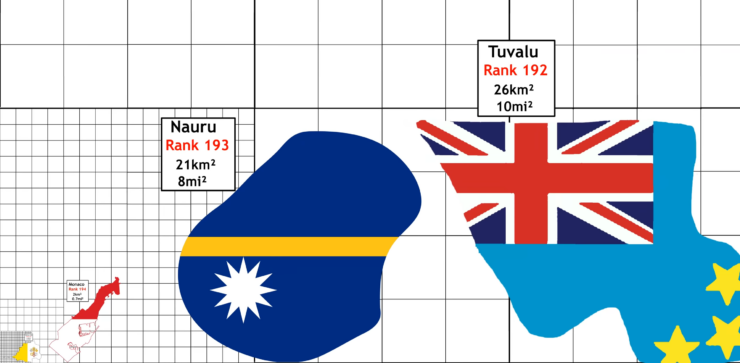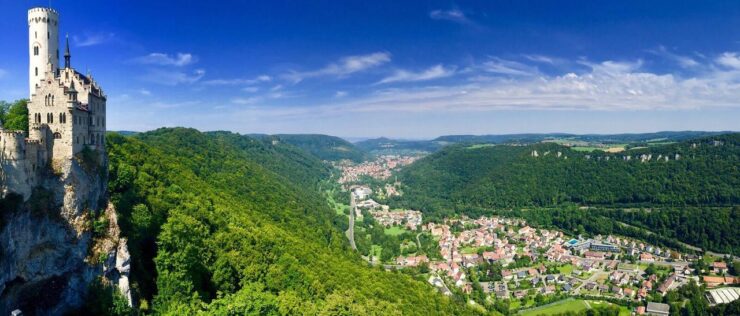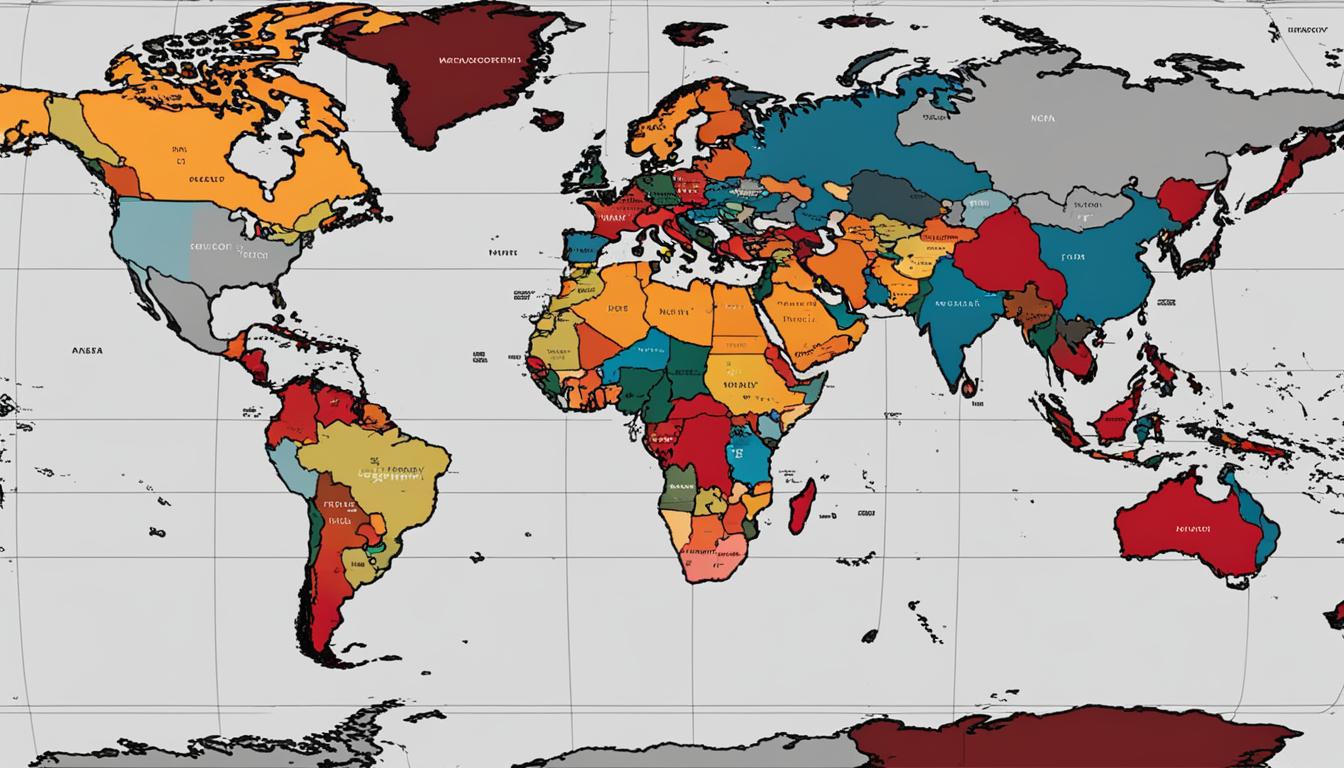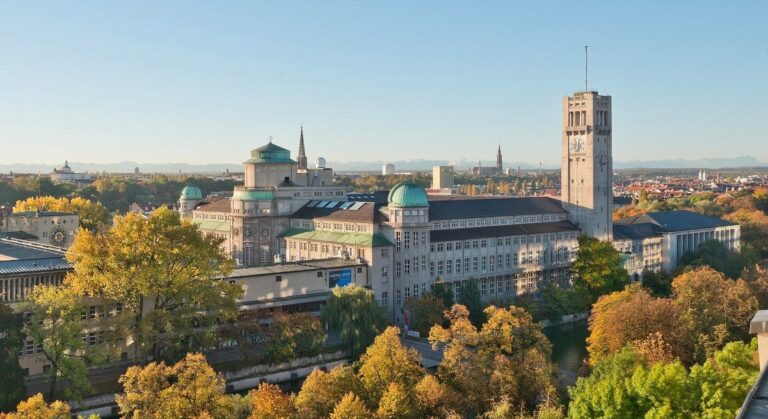Greetings, readers! Today, I am excited to explore the fascinating topic of the 30 smallest countries in the world in 2024. These unique nations, with their limited population and land area, hold a significant place on the global stage. Join me on this journey as we delve into the intriguing details surrounding the population, area, and rankings of these smallest countries.
Table of Contents
Key Takeaways:
- In 2024, we uncover the 30 smallest countries in terms of population and land area.
- Exploring the smallest countries provides insights into their cultural diversity and global impact.
- Size alone does not determine a country’s significance or influence.
- Small countries can offer unique travel experiences with rich histories and breathtaking landscapes.
- Despite their size, small countries contribute to global economies and political influence.
Understanding Total Area and Population Size

The total area of a country is a crucial measure in understanding its physical size. It encompasses both land and water area within its territorial borders and is often measured in square miles or square kilometers. However, it is important to note that the total area of a country does not solely determine its population size.
Population size is influenced by various factors such as geography, development level, and land use. While larger countries may have a higher potential for accommodating larger populations, smaller countries can still have significant populations due to factors like population density. Population density refers to the number of people per unit of land area, and it plays a significant role in determining the overall population size of a country.
“The total area of a country does not necessarily determine its population size, as factors like geography, development level, and land use also play a role.”
For example, countries with small land areas but high population densities can have relatively large populations. On the other hand, countries with vast land areas but low population densities may have smaller populations. Understanding the relationship between total area and population size is crucial in analyzing the demographic characteristics of countries around the world.
To gain a better understanding of the relationship between total area and population size, let’s explore a table of the largest countries by total area and compare it with a table of the largest countries by population in the next sections.
Top 10 Smallest Countries by Total Area
When it comes to land area, the top 10 smallest countries in the world are truly remarkable in their size. These countries may be small in territory, but they make up for it with their unique characteristics and cultural significance. Let’s take a closer look at the top 10 smallest countries by total area:
| No. | Country | Total Area (square kilometers) | Total Area (square miles) |
|---|---|---|---|
| 1 | Vatican City | 0.44 | 0.17 |
| 2 | Monaco | 2 | 0.78 |
| 3 | Nauru | 20 | 8.1 |
| 4 | Tuvalu | 30 | 11.6 |
| 5 | San Marino | 60 | 24 |
| 6 | Liechtenstein | 160 | 62 |
| 7 | Marshall Islands | 180 | 70 |
| 8 | Saint Kitts and Nevis | 260 | 101 |
| 9 | Maldives | 300 | 116 |
| 10 | Malta | 320 | 122 |
As we can see from the data, Vatican City is the smallest country by total area, measuring just 0.44 square kilometers (0.17 square miles). Monaco, Nauru, Tuvalu, and San Marino also have incredibly small territories, making them unique and fascinating destinations.
These small countries may not have vast land masses, but they offer rich historical and cultural experiences to visitors. From exploring the Vatican museums and St. Peter’s Basilica in Vatican City to enjoying the glamorous casinos and yachts in Monaco, each of these countries has something special to offer.
While their size may be small, the impact and influence of these countries on the global stage cannot be underestimated. Their unique histories, traditions, and political systems contribute to the cultural diversity of our world. Despite their physical limitations, these countries have managed to carve out a place for themselves in our global community.
Explore the Unique Charm of Small Countries
Visiting these small countries can be an eye-opening experience, allowing travelers to immerse themselves in a different world. Whether it’s the stunning beaches of the Maldives or the medieval architecture of San Marino, each of these nations offers a chance to witness a unique way of life.
Top 10 Smallest Countries by Population

When it comes to population, the smallest countries in the world may not have millions of citizens, but they still have unique characteristics and contribute to the global community. Let’s take a closer look at the top 10 smallest countries by population:
- Vatican City: With a population of just 800, Vatican City is the smallest country in the world by both area and population. It is the spiritual and administrative headquarters of the Roman Catholic Church.
- Nauru: With a population of approximately 10,876, Nauru is a small island country located in Micronesia. It faces various challenges due to its limited resources and remote location.
- Tuvalu: Tuvalu is a group of small islands in the Pacific Ocean with a population of around 11,931. It is known for its vulnerability to rising sea levels and its efforts to combat climate change.
- Palau: With a population of approximately 18,169, Palau is an island country located in the western Pacific Ocean. It is known for its pristine beaches and diverse marine life.
- San Marino: San Marino, a landlocked microstate in Southern Europe, has a population of around 34,017. It is one of the oldest republics in the world.
- Liechtenstein: With a population of approximately 38,250, Liechtenstein is a small country located between Switzerland and Austria. It is known for its high standard of living and strong economy.
- Monaco: Monaco, a glamorous city-state on the French Riviera, has a population of around 39,511. It is known for its luxury lifestyle, prestigious casinos, and the Formula 1 Grand Prix.
- Saint Kitts and Nevis: Saint Kitts and Nevis is a Caribbean country with a population of approximately 53,544. It is known for its beautiful beaches and vibrant culture.
- Marshall Islands: With a population of around 59,610, the Marshall Islands is an island country located in the Pacific Ocean. It faces challenges related to climate change and nuclear contamination.
- Dominica: Dominica is an island country in the Caribbean with a population of approximately 72,167. It is known for its lush rainforests, volcanic landscapes, and vibrant Creole culture.
Although these countries may be small in terms of population, they have their own unique identities, cultures, and contributions to the global stage.
The Influence of Small Countries
Small countries may not have the same physical size or population as their larger counterparts, but they have a significant impact on global affairs. These nations offer a wealth of unique cultures, diverse economies, and political systems that contribute to the global community.
Take, for example, Qatar and Singapore. These small countries have become major economic hubs, attracting businesses and investments from around the world. Through their strategic geographic locations and progressive policies, they have positioned themselves as key players in global trade and finance.
Additionally, small island nations in the Caribbean showcase the importance of tourism to their economies. These countries rely heavily on visitors seeking the natural beauty, vibrant cultures, and warm hospitality that these destinations offer.
Despite their size, small countries have the power to shape the world through their unique contributions in global affairs.
The Strength of Cultural Diversity
One of the most significant influences that small countries have is their preservation of unique cultures. These nations often uphold rich traditions, languages, and customs that make them stand out on the global stage. By celebrating and nurturing their cultural diversity, small countries bring different perspectives and ideas to the international community.
Political Impact on Global Issues

Small countries can also have a notable political impact, especially in areas where they have specific expertise or interests. Their voices are often heard on global issues such as climate change, human rights, and peacekeeping efforts. Despite their limited resources, small nations have the ability to shape policies and contribute to global solutions.
In summary, small countries may be small in size, but they possess unique qualities that allow them to exert a significant influence on global affairs. From their diverse cultures and thriving economies to their political contributions, these nations play a vital role in shaping the world we live in.
Challenges Faced by Small Countries

Small countries face a unique set of challenges that can significantly impact their development and stability. One of the main challenges is limited resources. With a smaller land area and population, these countries often have fewer natural resources and a limited capacity for economic growth. This can hinder their ability to compete globally and create sustainable sources of income.
Vulnerability is another major challenge for small countries. Many of them are located in geographically vulnerable regions, such as small island nations in the Pacific or Caribbean. These countries are exposed to environmental hazards, including the impacts of climate change. Rising sea levels, extreme weather events, and coastal erosion pose significant threats to their infrastructure, economy, and even their very existence.
Climate change is a particularly pressing challenge for small countries. The global rise in temperatures and the resulting changes in weather patterns have severe consequences for these nations. They are often disproportionately affected by the negative impacts of climate change, such as increased frequency and intensity of storms, droughts, and flooding. These challenges require proactive measures and international cooperation to mitigate their effects and ensure the sustainability of small countries.
“Small countries face unique challenges due to their limited resources and vulnerability to external forces. The impacts of climate change, in particular, pose significant threats to these nations, requiring urgent action and support from the international community.”
| Challenges | Description |
|---|---|
| Limited Resources | Smaller land area and population result in limited natural resources and economic opportunities. |
| Vulnerability | Geographically vulnerable regions, such as small island nations, are exposed to environmental hazards and climate change impacts. |
| Climate Change | Rising temperatures, extreme weather events, and sea-level rise pose significant threats to infrastructure, economy, and overall sustainability. |
Despite these challenges, small countries often display resilience and a strong sense of national identity and pride. They seek innovative solutions, engage in international cooperation, and strive for sustainable development to overcome their limitations and contribute to the global community.
Notable Small Countries Worth Visiting
While small in size, some countries offer unique experiences for visitors. Andorra, Bhutan, Liechtenstein, San Marino, and Seychelles are noteworthy examples. These countries boast diverse cultures, rich histories, and stunning natural beauty that make them worth exploring for those seeking alternative travel destinations.
Andorra, nestled in the Pyrenees mountains between France and Spain, is known for its picturesque landscapes, ski resorts, and duty-free shopping. Visitors can explore its charming old town, and Romanesque churches, and enjoy outdoor activities like hiking and skiing.
Bhutan, located in the eastern Himalayas, is a country renowned for its commitment to Gross National Happiness, Buddhist traditions, and breathtaking scenery. Travelers can immerse themselves in the country’s unique cultural heritage, visit ancient monasteries, and trek through the stunning landscapes of the Paro Valley or the iconic Tiger’s Nest.
Liechtenstein, a small principality nestled between Switzerland and Austria, offers a blend of natural beauty and cultural wealth. Visitors can explore the capital Vaduz, visit medieval castles, and enjoy outdoor activities like hiking and skiing in the picturesque Alpine landscapes.
San Marino, one of the world’s oldest republics, is a microstate entirely surrounded by Italy. This small country is known for its medieval architecture, including the historic walled city of San Marino, perched on a hilltop offering panoramic views. Visitors can explore the narrow streets, visit ancient fortresses, and indulge in the local cuisine.
Seychelles, an archipelago of stunning islands in the Indian Ocean, is renowned for its pristine beaches, crystal-clear waters, and vibrant marine life. Travelers can relax on white sandy beaches, snorkel or dive in the coral reefs, and visit nature reserves to spot unique wildlife like giant tortoises.
| Country | Main Attractions | Unique Features |
|---|---|---|
| Andorra | Picturesque landscapes, ski resorts, duty-free shopping | Charming old town, Romanesque churches |
| Bhutan | Buddhist monasteries, Paro Valley, Tiger’s Nest | Commitment to Gross National Happiness |
| Liechtenstein | Medieval castles, Alpine landscapes, outdoor activities | Blend of natural beauty and cultural wealth |
| San Marino | Historic walled city, ancient fortresses, local cuisine | One of the world’s oldest republics |
| Seychelles | Pristine beaches, coral reefs, nature reserves | Vibrant marine life, giant tortoises |
These notable small countries offer a glimpse into unique cultures, rich heritage, and breathtaking scenery. Whether you’re seeking outdoor adventures, cultural exploration, or simply a relaxing beach getaway, these destinations provide unforgettable experiences for travelers looking beyond the usual tourist hotspots.
Comparing Land Area and Population Rankings
When we compare countries’ rankings by land area and population, we can gain insights into the contrasting characteristics of different nations. Larger countries may have vast land areas, while smaller countries often have higher population density.
Let’s take a closer look at a couple of examples. Mauritius, with a land area of 28 km², ranks first in terms of land area but is placed 143rd in population, with 1,291,456 residents. This indicates that despite its relatively small size, Mauritius has a significant amount of land available but a lower population compared to other nations.
On the other hand, Nauru, with a land area of 21 km², ranks second in land area but is ranked 197th in population, with just 11,121 people. This means that Nauru has a small land area, yet its population is even smaller, highlighting its unique demographic situation.
| Country | Land Area (km²) | Population | Population Rank |
|---|---|---|---|
| Mauritius | 28 | 1,291,456 | 143 |
| Nauru | 21 | 11,121 | 197 |
These examples illustrate how land area and population rankings can provide valuable insights into the unique characteristics of different countries. Whether a country’s land area is large or small, and whether its population is dense or sparse, each nation plays a distinct role in the global landscape.
The Significance of Small Countries
Despite their size, small countries play a crucial role in global affairs, contributing to cultural diversity, international diplomacy, and political influence. These nations may lack the physical landmass and vast populations of their larger counterparts, but they make up for it with their distinct identities and unique contributions to the world stage.
One of the most significant ways small countries impact global affairs is through their rich cultural diversity. These nations often have vibrant traditions, customs, and languages that contribute to the global tapestry of human experience. They offer a glimpse into alternative ways of life, fostering understanding and appreciation among nations. Small countries also provide unique opportunities for cultural exchange and tourism, attracting visitors who seek to immerse themselves in diverse and authentic experiences.
Small countries also have the power to shape political discourse and influence international decision-making. Despite their limited resources, they often have a strong voice in global forums and organizations, advocating for their interests and pushing for solutions to key global challenges. Their input is valuable in addressing issues such as climate change, human rights, and economic development. Through their active engagement, small countries can help drive positive change on a global scale.
Ultimately, the significance of small countries lies in their ability to challenge traditional notions of power and influence. While large countries may dominate headlines and have greater geopolitical clout, small nations offer a refreshing perspective and alternative paradigm. They remind us that size does not determine impact, and that every voice matters in the complex fabric of international relations.
Size Isn’t Everything

When it comes to countries, size is often seen as a measure of significance. However, small countries prove that size doesn’t matter. In fact, being a small country offers unique opportunities and advantages that larger nations may not have. Despite their size, these countries have a strong sense of national identity and pride.
Small countries are often able to preserve their cultural heritage and traditions more effectively than larger nations. Their compact size allows for close-knit communities and a sense of belonging that fosters a strong national identity. This can be seen in countries like Iceland, where the population’s shared history and pride in their unique culture is celebrated.
Additionally, small countries have the opportunity to be agile and adaptable in the global arena. They can often respond quickly to changing circumstances and make decisive decisions that propel their economies and societies forward. This flexibility allows them to carve out niche industries and excel in areas where larger countries may struggle to compete.
Furthermore, small countries often have close-knit diplomatic networks and can maintain strong international relationships. They are able to engage on a personal level with other nations and make a meaningful impact on global issues. This ability to forge connections and engage in diplomacy is a testament to the power of small countries.
| Country | Population (2024) | Total Area (km²) |
|---|---|---|
| Vatican City | 800 | 0.44 |
| Nauru | 10,876 | 21 |
| Tuvalu | 11,931 | 30 |
| Palau | 18,169 | 459 |
| San Marino | 34,017 | 61 |
Conclusion
In conclusion, the 30 Smallest Countries in the World in 2024 offer unique destinations that showcase cultural diversity and have a global impact. Despite their size, these countries have rich histories, breathtaking landscapes, and vibrant cultures that make them worth exploring. From Vatican City and Monaco to Nauru and Tuvalu, each of these countries has its own distinct charm and allure.
Visiting these small countries allows travelers to experience the world in a different way, immersing themselves in the local traditions, cuisine, and landmarks. Whether it’s exploring Vatican City’s historic sites, enjoying the luxurious lifestyle of Monaco, or discovering the tropical beauty of Nauru and Tuvalu, these destinations provide unforgettable experiences.
Furthermore, these small countries contribute significantly to the global community. They may have limited physical size, but they have a big impact on various aspects of global affairs, including culture, economy, and politics. Their unique perspectives and contributions help shape the world we live in and foster global cooperation and understanding.
FAQ
What are the 30 smallest countries in the world in 2024?
The 30 smallest countries in the world in 2024 are determined by both their population and land area.
How is the total area of a country measured?
The total area of a country is measured in square miles or square kilometers, and it includes both land and water within its borders.
Does the total area of a country determine its population size?
No, factors like geography, development level, and land use also play a role in determining a country’s population size.
What are the top 10 smallest countries by total area?
The top 10 smallest countries by total area are Vatican City, Monaco, Nauru, Tuvalu, San Marino, Liechtenstein, Marshall Islands, Saint Kitts and Nevis, Maldives, and Malta.
What are the top 10 smallest countries by population?
The top 10 smallest countries by population are Vatican City, Nauru, Tuvalu, Palau, San Marino, Liechtenstein, Monaco, Saint Kitts and Nevis, Marshall Islands, and Dominica.
What impact do small countries have on global affairs?
Small countries contribute to cultural diversity, global economies, and political influence. Despite their size, they play a vital role in shaping the world we live in.
What challenges do small countries face?
Small countries face challenges such as limited resources and vulnerability to external forces. Many small island nations are particularly vulnerable to the impacts of climate change.
Which small countries are worth visiting?
Notable small countries worth visiting include Andorra, Bhutan, Liechtenstein, San Marino, and Seychelles. These countries offer unique cultures, rich histories, and stunning natural beauty.
How do rankings of land area and population differ?
Rankings of land area and population can differ significantly. Some large countries have sparsely populated areas, while small countries can have high population density.
What is the significance of small countries?
Despite their size, small countries have a significant impact on global affairs. They contribute to cultural diversity, global economies, and political influence.
Does size determine a country’s significance?
No, size doesn’t determine a country’s significance or its ability to make an impact on the world stage. Small countries can have a unique national identity and pride.
Source Links
- https://www.southwestjournal.com/smallest-countries-in-the-world-2023-by-population-and-area/
- https://worldpopulationreview.com/country-rankings/smallest-countries
- https://wisevoter.com/country-rankings/smallest-countries/
Related Posts:
- Top Smallest Countries in 2024 by Size & People
- Hottest Countries in the World 2024: Chasing Sunsets Guide
- Explore Biggest Cities in Canada 2024 - by Population
- Best Smallest ATX Cases: Compact Options for Your Build
- Exploring the World of Roulette: European, American,…
- The Intersection of Gaming and Education: Learning…













